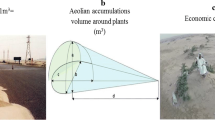Abstract
In arid and semi-arid regions, the dust storms are a common phenomenon. Kuwait is an arid country. Most of the lands in Kuwait are desert with low density of vegetation cover; therefore, these areas are exposed to dust most of the year. With the effect of wind particles move in three different modes of transport as creep, saltation, and suspension. The saltating particles on hitting the surface dislodge particles to air, they remain in air for longer period, and this process is called suspension. This commonly form thick sand cloud across the country during dust storm. The total numbers of dusty days in Kuwait are 255.4 days. It means that sandstorms and dust storms occur almost all the year. Most dominant plant species have the ability to trap sediments (sand and fallen dust) and form sandy mound around it called nabkha. There are three types of nabkhas based on their sizes: small, medium, and large nabkhas. The efficiency of trap** sediment depends on the height of canopy and size of bush of nabkhas. Different perennial plant species can form nabkhas such as Haloxylon salicornicum, Cyperus conglomerates, Rhanterium epapposum, Astragallus spinosus,Citrullus colocynthis, Halocnemum strobilaceu, Salicornia europaea, Tamarix aucheriana, Lycium shawii, and Nitraria retusa. Each plant must reach 10–15 cm in height before they can effectively trap sand. Once trapped in a nabkha, these cemented particles do not readily become wind re-entrained. Individual plant can form nabkha with unique sedimentological and morphological characteristics. The efficiency of the plant species in trap** sand was measured by estimating the volume of trapped sand for each plant. N. retusa, H. salicornicum, and L. shawii are the most efficient plant species in Kuwait in trap** mobile sand. These species trapped an average of 2, 1.25, and 1.2 m3, respectively, of mobile sand and fallen dust. Most surface sediments consisted of coarse, medium, fine and very fine sand and few mud. Native plant species plays a major role in minimizing, controlling, and reducing fallen dust.




Similar content being viewed by others
References
Al-Dousari AM, Ahmed M, Al-Senafy M, Al-Mutairi M (2008) Characteristics of nabkhas in relation to dominant perennial plant species in Kuwait. Kuwait J Sci Eng 35(1):129–150
Cooke RU, Warren A, G-oudie AS (1993) Desert geomorphology. UCL press, London
Gautier EF, Chudeau R (1909) Missions au Sahara,1: Sahara Algerien. Armand Colin, Paris
Goudie A (1990) The landforms of England and Wales. Basil Blackwell, Oxford, 394 pp
Khalaf FI, Misak R, Al-Dousairi A (1995) Sedimentological and morphological characteristics of some nabkha deposists in the northern coastal plain of Kuwait, Arabia. J Arid Environ 29:267–292
Author information
Authors and Affiliations
Corresponding author
Additional information
This article is part of the Topical Collection on DUST
Rights and permissions
About this article
Cite this article
Ahmed, M., Al-Dousari, N. & Al-Dousari, A. The role of dominant perennial native plant species in controlling the mobile sand encroachment and fallen dust problem in Kuwait. Arab J Geosci 9, 134 (2016). https://doi.org/10.1007/s12517-015-2216-6
Received:
Accepted:
Published:
DOI: https://doi.org/10.1007/s12517-015-2216-6




